For Sale: Wild Russian Killer Whales
As Westerners condemn live whale shows, Russia hunts and sells killer whales to Chinese amusement parks.
Article body copy
The boat circled a pod of killer whales feeding peacefully on fish. The crew had already pursued several different whale groups over the past few days with no success. After 10 failed capture attempts, the hunters knew their targets weren’t easy prey. So this time, the crew was patient and kept circling to lull the animals into complacency.
When the whales seemed calm enough, the crew flung the encircling nets, and quickly realized how many animals they faced: about 20 whales, adults and calves, frantically swam around inside the enclosure. Within minutes, the animals discovered escape routes and rushed to break free.
“The adults moved toward the stern and began to escape over the net. They did it in an amazing way: a killer whale would come right up to the floats, and then roll over its back, upside down,” a crew member later recalled, in a written account of the capture. “At the same time, the young animals dashed to the ship’s bow and tried to force through [any gaps].”
The net emptied fast, but the hunters lucked out. One youngster’s pectoral fin got stuck between a float and the steel rope at the top of the net. The divers on deck, paid to jump into the water and help lift captured animals onto the boat, were scared by the killer whale’s might; they froze until other crew members reportedly forced them into action. When the nets lifted, another body appeared—a small one. Tangled deep down in the net, the calf had died. “Being busy with the first one, we didn’t notice the other one and it drowned,” the crew member said. They cut the net and dumped the body into the ocean.
In 2003, a net encircled members of several pods of killer whales in Kamchatka waters. The hunters had no experience in capturing orcas, and as a result, several whales became entangled in the net. Video by Far East Russia Orca Project, courtesy of Erich Hoyt
A video of the ordeal shows another whale getting entangled in the net as it attempts an escape. As the whale splashes and struggles, ramming its head against the floats, one captor yells, “It’s tangled, it’s tangled! It will drown!” A second crew member calmly replies, “It doesn’t matter, we’ll get another one.”
This 2003 hunt for killer whales off the coast of the Kamchatka Peninsula in Russia’s far east, the first capture in Russian waters for commercial purposes, echoes earlier hunts oceans away. In the 1970s, aquariums—from Vancouver, British Columbia, to Orlando, Florida, to Mexico City—scrambled to net killer whales in European and North American waters. As star marine megafauna, killer whales lured in a paying audience who, at the time, thought little of how the animals lived or that performing for the crowd might not keep the animals free from boredom. Eventually, public sentiment shifted. First against hunting, then—helped along by American documentaries Keiko: The Untold Story in 2010 and Blackfish in 2013—against whales in confinement, period.

The Kamchatka Peninsula is bordered by the Pacific Ocean, the Sea of Okhotsk, and the Bering Sea. Whales are caught off Kamchatka by indigenous peoples and those who plan to use the animals for “scientific, cultural, and educational purposes.” Illustration by Mark Garrison
Whales remain in captivity in the West, but facilities have been closing over the past few years. In Russia, as well as China (which buys whales from Russia), more facilities have been opening. “The general public in China and Russia is a bit out of step with the Western sensibilities in terms of animals,” says marine mammal scientist Naomi Rose of the Animal Welfare Institute in Washington, DC. “They are where the Western world was 40 to 50 years ago.”
Killer whales in the Sea of Okhotsk and surrounding waters off Kamchatka, are caught in a different zeitgeist than their cousins an ocean away, and it’s killing them.
In China, the marine theme park industry is surging. According to a 2015 report prepared by the China Cetacean Alliance, Ocean Theme Parks: A Look Inside China’s Growing Captive Cetacean Industry, China has 39 operational ocean theme parks, housing 491 cetaceans from 11 different species, and it’s building 14 more parks. “The Chinese don’t capture killer whales, but they are willing to pay a pretty penny for them,” says Erich Hoyt, codirector of the Far East Russia Orca Project (FEROP) and a research fellow with the United Kingdom’s Whale and Dolphin Conservation. The cost of a live killer whale is, at minimum, US $1-million, a price tag that gives Russian whalers more than enough incentive.
In 1999, Hoyt, who has researched whales and dolphins all over the world, started FEROP with two collaborators, codirector Alexander Burdin and Japanese researcher Hal Sato. It began as a pilot research project on the killer whales inhabiting the northwest Pacific Ocean, a group that wasn’t being studied at all. He brought Russian scientists onboard and trained them in photo identification and other techniques.
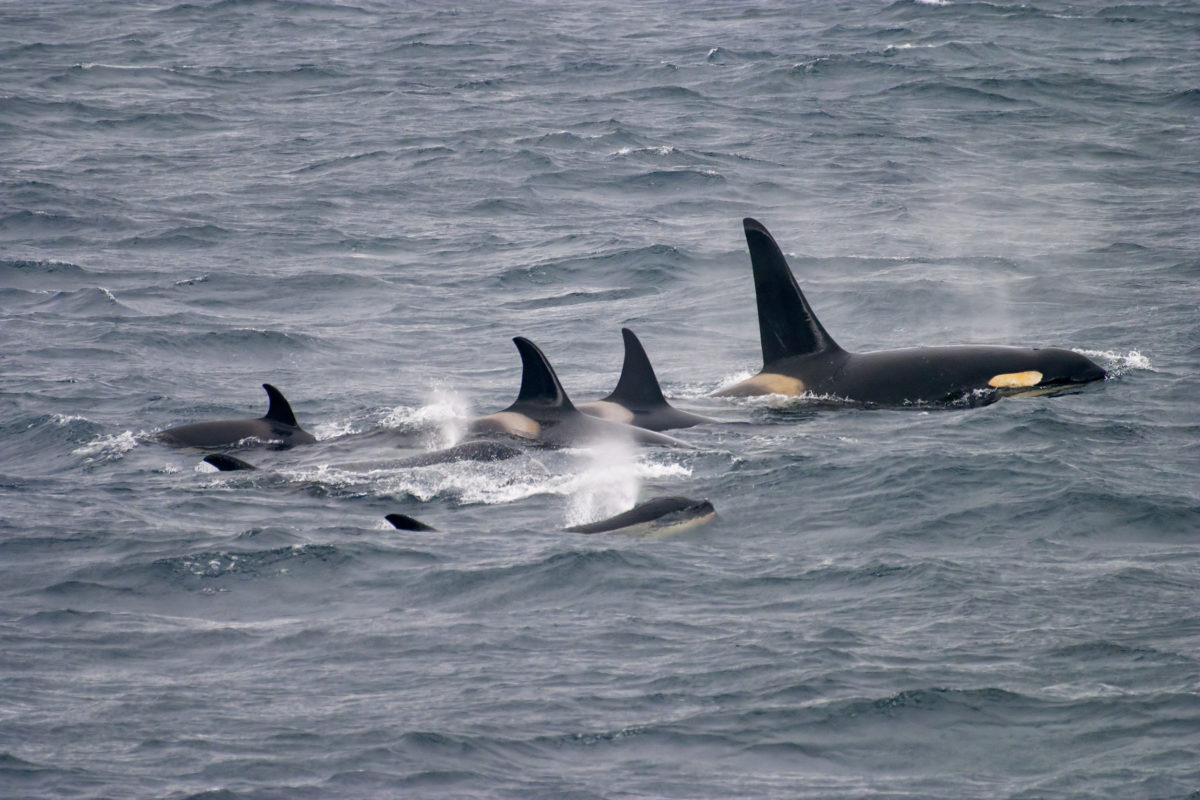
A pod of killer whales swims off the coast of the Kamchatka Peninsula in Russia’s far east. Photo by Martin Hale/Minden Pictures
Monitoring captures of any kind is very difficult in Russia. The Kamchatka Peninsula, which occupies 370,000 square kilometers, is essentially a wild frontier. Bordered by the Pacific Ocean to the east, the Sea of Okhotsk to the west, and the Bering Sea to the northeast, the peninsula is reachable only by plane, boat, or helicopter. Kamchatka has historically been a few man’s land, rich with wildlife and fish, and where hunting and fishing have always been a part of life. Whale hunting is illegal in Russia today, except for members of the indigenous tribes that live along the coast of the Chukchi and Bering Seas. Government regulations, however, permit capturing whales for “scientific, cultural, and educational purposes,” within an allowable quota. According to FEROP, regulators often ignore the quotas recommended by the organization, advice that’s based on scientific facts established by marine mammalogists. In the past, when FEROP recommended a quota of zero, the regional fisheries managers at the Pacific Fisheries Research Center (TINRO-Center) and the Russian Federal Research Institute of Fisheries and Oceanography—which view marine mammals, including whales, as a fishery resource—allowed around 10 captures.
Today, three captured killer whales perform in shows at the new Moscow aquarium, Moskvarium, which opened in 2015. Russian killer whales have also been sent to Chimelong Ocean Kingdom, one of the world’s largest aquariums, in Zhuhai, in China’s Hunan Province: two in 2013, five in 2014, and two in 2015. The whales were finally shown to the public in February. Some of the whales remained unseen for two years before they were put on display for the public, making animal rights activists all over the world worry that some may have died, unable to adjust to captivity, Rose said. Luckily, all the animals were still alive. “Assuming, of course, that these nine orcas are the original nine, which can’t be confirmed,” Rose notes.
It will be hard for the general public to understand the killer whales’ true fate through the haze of entertainment without educational efforts in both countries. Westerners might be more informed of the ethics of keeping killer whales in captivity, but that knowledge is fairly recent. Throughout most of history, the human interpretation (at least in the Western canon) of these creatures and their behaviors has been exceptionally flawed: killer whales have been cast as brutes, a distasteful animal in the realm of animal stories, more foe than friend, more bully than buddy. Education, and, ironically, captivity helped change perceptions.
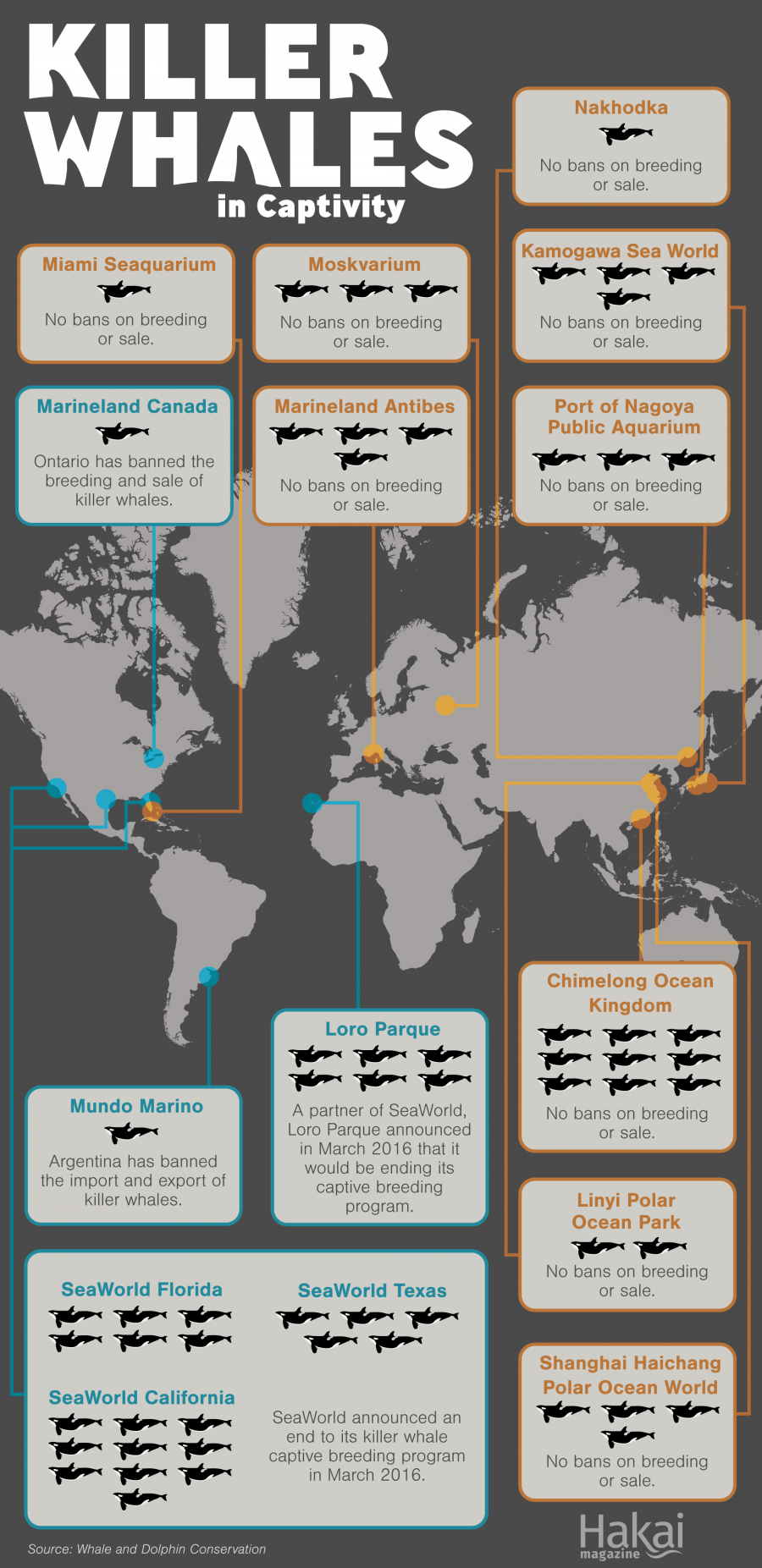
Research by Amorina Kingdon, illustration by Mark Garrison
Orcinus orca was slower than other marine mammals, such as dolphins, to earn the love and affection of humans. Interestingly, some killer whale populations eat dolphins and some don’t, but modern science lumps all killer whales and dolphins into the family Delphinidae. Killer whales are top marine predators: the largest grow up to 10 meters long, weigh up to 10 tonnes, gobble up to 130 kilograms of fish a day, and chase prey at 50 kilometers per hour. Our ancestors saw these creatures as deadly sea beasts—orca means “a whale” and Orcinus means “belonging to the realm of the dead.”
In his book Orca: The Whale Called Killer, Hoyt traces humans’ fear of these animals from antiquity to modern day. The dolphin-loving Greeks weren’t fond of the dolphin-eating killer whales. Roman naturalist Pliny the Elder wrote of them as the ultimate predators, “an enormous mass of flesh armed with savage teeth.” During the Middle Ages, killer whales were seen as sea monsters. In 1862, Danish zoologist Daniel F. Eschricht examined the stomach contents of an adult male killer whale and claimed he found pieces of 13 porpoises and 14 seals. Hoyt notes that whalers reported witnessing packs of killer whales attacking and taking bites of other whales, often several times their size. Scientists aboard whaling ships described finding parts of every other kind of whale inside killer whales’ stomachs. Such accounts further fed the perception that the whales were insatiable predators.
Yet, depending on the population and its environment, killer whales’ diets, behaviors, and social ties differ. The Kamchatka killer whales fall into the same two distinct groups as whales in the northeastern Pacific. Some are resident whales, pods that have rigid societal ties and mostly feed on fish. Others are transients: their travel patterns bring them closer to rocky shores; their societal ties are more flexible; and they feed primarily on marine mammals, including seals, porpoises, dolphins, and sea lions. Currently, both killer whale types are classified as the same species. There have been talks about splitting them into separate species, but any big changes would require an in-depth examination of killer whale populations worldwide. There’s still a lot to learn about the animal’s characteristics and behaviors, and FEROP is working hard on that in Kamchatka.
Killer whales perform at the Moscow aquarium, Moskvarium, which opened in 2015. Video by Ruptly
Every summer, FEROP group members leave their respective home bases in Moscow, St. Petersburg, and elsewhere, and head for Russia’s eastern shores, where they set up a research camp in the wilds—large tents that fit their beds, tables, and equipment. During July and August, they venture out on small inflatable boats, looking for killer whale pods. FEROP member Olga Filatova says the team knows the whales by sight—or more specifically, by the shape of their fins, the saddle patch behind the fin, and by scars and notches individual whales accumulate over time. The creatures are tolerant of the scientists’ scrutiny. “We don’t know if it’s because killer whales got used to us or because we got better at getting close to them without disturbing them,” Filatova says.
Social mammals that live and travel in family pods, killer whales hunt, eat, and socialize together. Off Kamchatka (as in the northeast Pacific), the oldest female typically leads a pod of resident whales, and calves remain with their mothers for life, Filatova says. “When the oldest mother dies, her daughters become the matriarchs of their own families—and the old family splits up,” Filatova says.
The scientist often draws parallels between humans and the marine mammals, especially when it comes to social learning—an important part of killer whale society. Insights gained by Filatova and her colleagues from observations in the wild beyond Russia are complemented by lab work, most notably by Lori Marino, a cetacean neuroscience researcher involved with groundbreaking research on dolphin and whale cognition.
Marino, a researcher at Emory University in Atlanta, Georgia for 19 years, is an expert in animal behavior and intelligence. As part of her research she investigates whale brains post-mortem.
When a cetacean, such as a killer whale, beaches itself or dies in an aquarium, Marino preserves the brain in formaldehyde until it loses its jelly-like consistency and hardens enough to be placed in an MRI machine. Marino uses the MRI to digitally slice through brain structures so she can view their proportions, spatial locations, and interconnections. From that, Marino forms hypotheses and conclusions about killer whales’ brain functions, such as communication, perception, and even emotion.
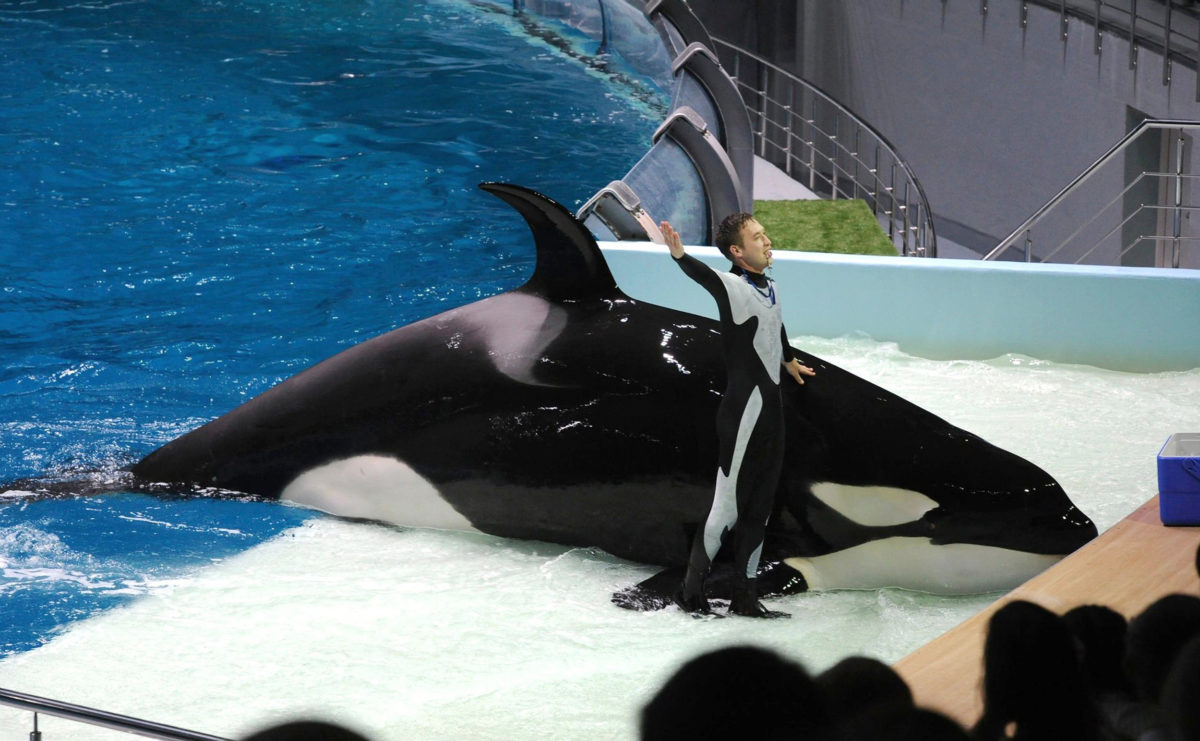
A trainer and a captive killer whale receive cheers from the crowd following a performance at the Moskvarium, the new aquarium in Moscow, Russia. Photo by Russian Government/Alamy Stock Photo
Killer whale brains are larger and in some ways more complex than ours. An average human brain weighs about 1,300 grams while an average killer whale brain weighs 5,000 grams. This year, Marino’s research group discovered that, unlike humans who have only one auditory system in their brains, dolphins have two—one that they use for echolocation and one for some other form of communication. Marino thinks killer whales likely have a similar second system, too.
It’s possible that the needs of killer whales demand a more complex brain structure than humans. Compared to us, killer whales have a more developed paralimbic lobe located next to the limbic system, the brain’s emotional center. “That tells you that they have very strong emotions—and those emotions play out in everything from the relationship between family members, mother-child, to the strength of the bonds in the pod,” Marino says. As highly emotional creatures, killer whales might experience emotions on a different level than we do and their behavior suggests they are more socially bonded to each other than humans are to each other. “You can see that their brain elaborates on emotions in some way that’s not necessarily done in humans.”
Killer whales also have one of the most complex neocortices on the planet. The neocortex is involved in high-level cognition such as self-awareness, problem solving, and intellect. “When you look at their brain and especially the neocortex, you find that it’s more convoluted than in humans,” says Marino. It’s apparent that something in the animals’ evolutionary past demanded a degree of cognitive sophistication.
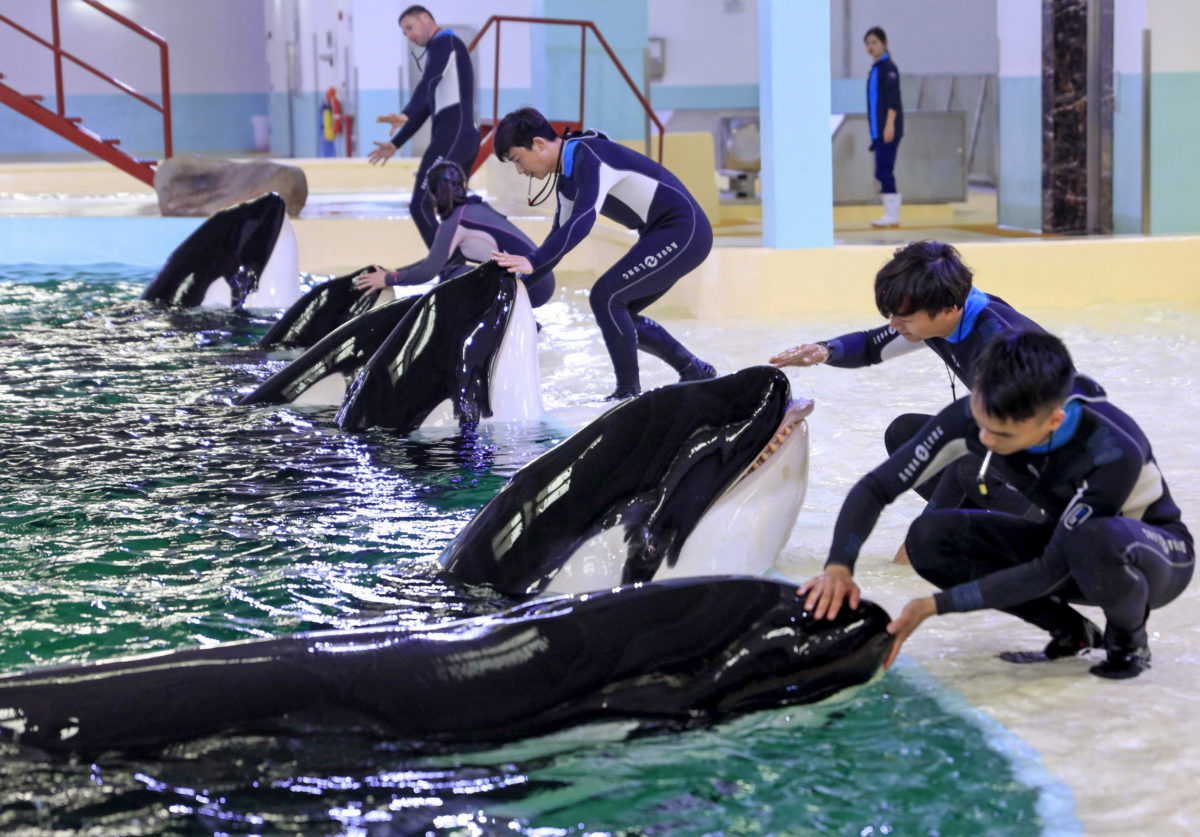
Trainers interact with captive killer whales at China’s Chimelong Ocean Kingdom. Last month, the facility became home to China’s first breeding center for killer whales. Photo by Liu Dawei Xinhua News Agency/Newscom
Generally, we tend to view animals as intellectually inferior to us. But what we do wrong, Marino says, is that we set ourselves as a benchmark. “If we use humans as the measuring sticks of intelligence for all other animals, the animals will have to fall short because they’re not humans,” Marino says. “If orcas were doing the rankings, humans would never measure up to being an orca.”
After the fouled 2003 capture, the hunt for killer whales in Russia’s far east seemed to stop for a while. But in 2012, the captures resumed. A young female killer whale, named Narnia by her captors, was taken from the Sea of Okhotsk to a facility in Nakhodka, a port city to the south, relatively close to North Korea. A year later, a young male, a young female, and an adult female, possibly their mother, were caught in the same area, joining Narnia in her Nakhodka holding pen. The newly arrived trio initially refused to eat, but some observers report that Narnia started bringing them fish and convinced them to start feeding—one prisoner helping out others.
Narnia eventually ended up at the Moskvarium, and the two youngsters were supposedly shipped to China, although the paper trails of captive killer whales in Russia are often hard to verify. While there are different opinions on when the whales arrived, everyone agrees the Chimelong facility now has nine killer whales. During the journey, animals are confined to tanks in which they can’t turn around. “Planes used to be the main way, but now trucks are used most often,” says a China Cetacean Alliance representative in China, who didn’t want to be identified. “Some aquariums are in southwestern China or southeastern China [and] the journey can take up to four or five days.” While the Moscow aquarium was being built, two captive killer whales, Narnia and Nord, lived in rusted (at least on the outside) water cisterns for months until their enclosures were ready, says Oxana Fedorova, who founded the activist group Save Dolphins, which monitors all captive dolphins, killer whales, and belugas in Russia. The third killer whale, named Malvina, arrived in time for the grand opening. Later, the Moskvarium renamed her Juliette.
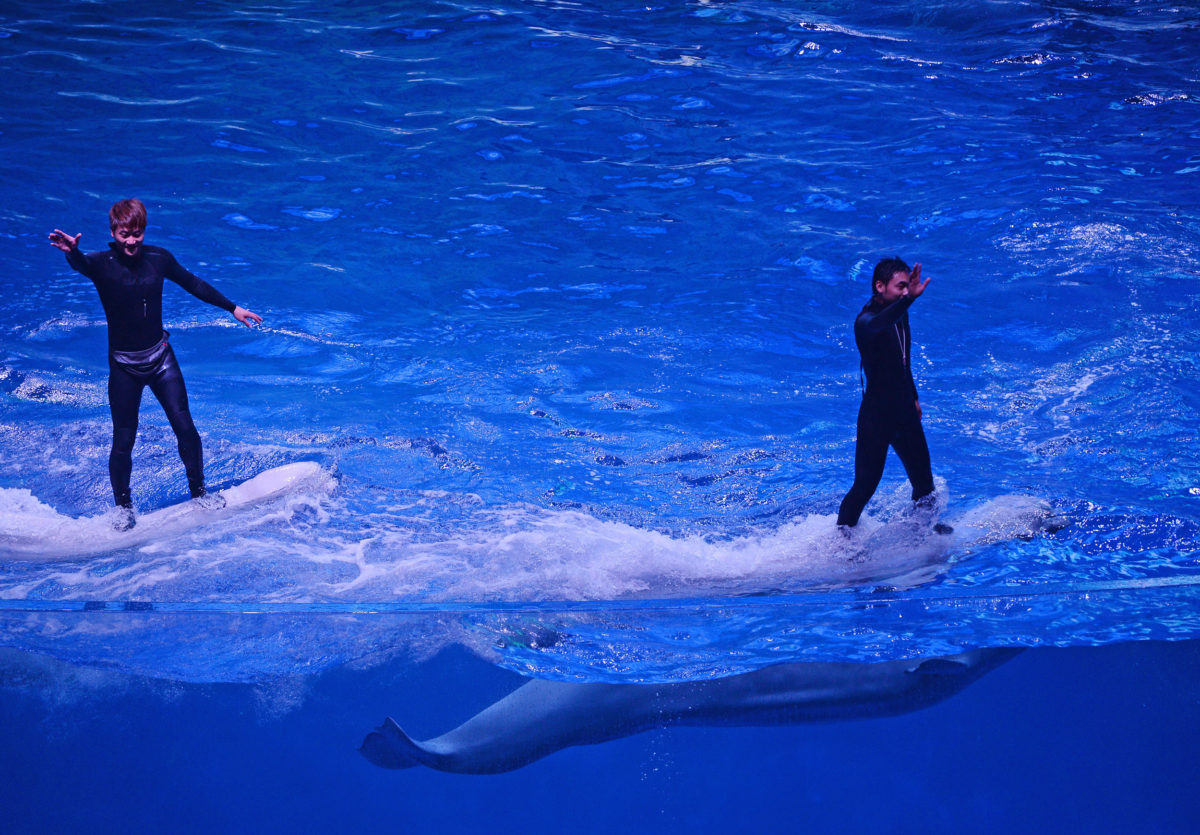
Trainers ride beluga whales during a performance at Chimelong Ocean Kingdom, one of the world’s largest ocean theme parks. Photo by Mark Ralston/AFP/Getty Images
Capturing the whales for display, as distasteful as it is to Westerners, poses an even darker threat: extinction. The transient killer whales of eastern Russia are the most threatened by the captures because there are fewer of them compared to resident killer whales, and because they’re easier to snatch since they feed closer to shore. Of the few thousand killer whales inhabiting eastern Russia, only a few hundred are transient. The quotas don’t differentiate between the two. “At that rate, they may just capture all of them,” Filatova says, meaning that the population could collapse if captures continue unabated.
Other marine mammals, such as resident killer whales and belugas, may not be facing extinction, but they share a similar fate: more and more aquariums are being built, mostly—and rapidly—in China. Marine parks and shows make great attractions. Enamored and awed by the creatures, most people fail to realize the animals’ plight. In the news, training facilities are portrayed as caring institutions, marine mammals as happy, and their arrivals as celebratory events.
“The public in China is not very aware of the suffering of the marine animals just like the public in the Western world in the 1980s,” says the China Cetacean Alliance rep, adding that the organization tries to educate both adults and children about the problem. Fedorova echoes that, explaining by email that to change the situation, one must change the public’s mindset, which is no easy task. “I’ve been asking myself the question, ‘What would be [the] best awareness strategy?’ for a long time and I always come to the same answer: that we have to have enough resources to work in different [audiences],” she says. “It’s important to work with kids and adults at the same time, especially in Russia, because [the] majority of people there just don’t know the truth.” Fedorova adds that in the past few years, Save Dolphins has had opportunities to adopt captive dolphins, but was held back. “We simply don’t have a place we can take them, like a rehab center.” The group has begun the work to create a rehabilitation center for the marine mammals.
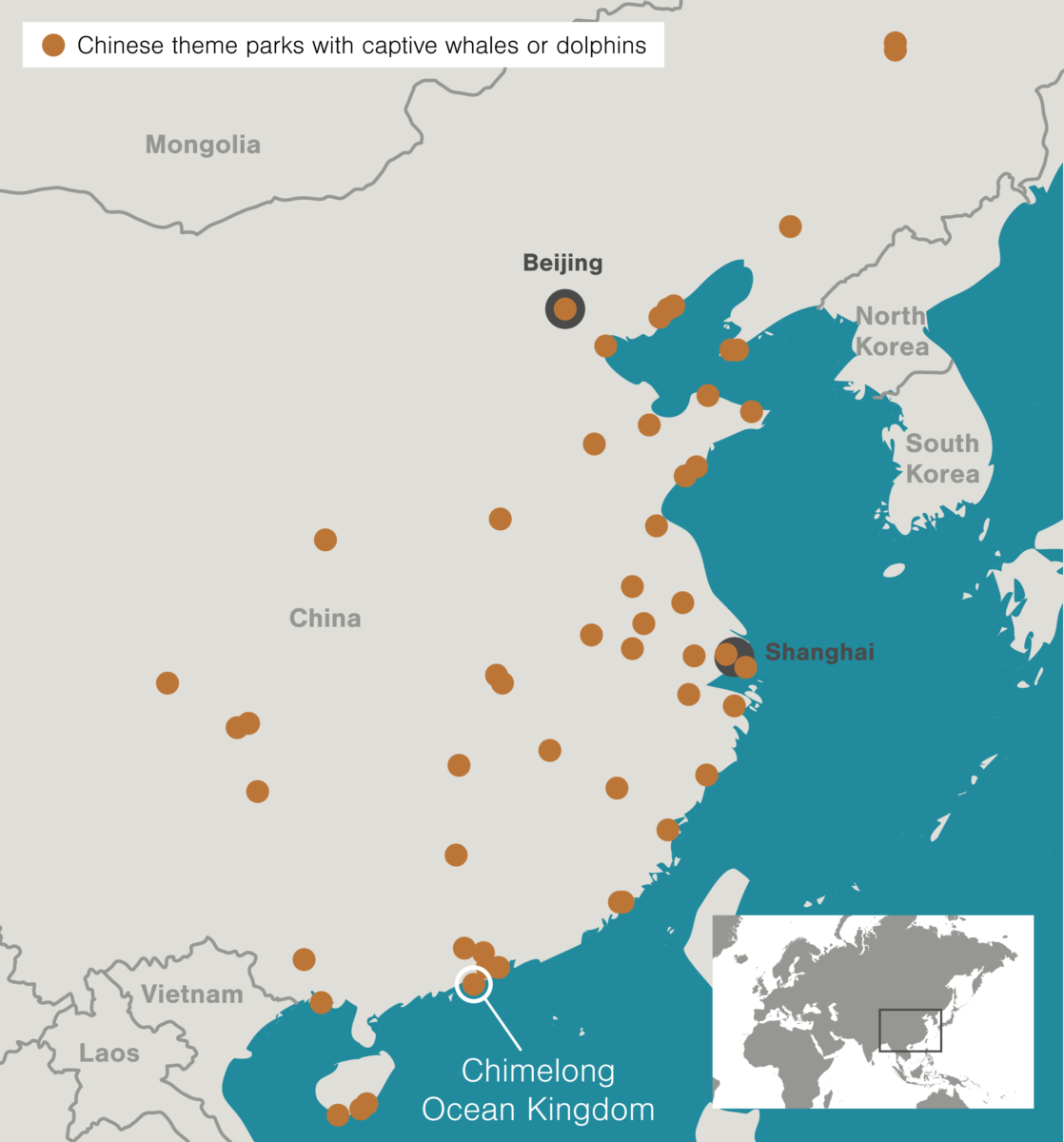
China has 39 ocean theme parks and plans to build 14 more, according to China Cetacean Alliance. Source: Ocean Theme Parks: A Look Inside China’s Growing Captive Cetacean Industry (2015), illustration by Mark Garrison
In 2016, it looked like Russia’s transient killer whale population could avoid catastrophe. Hoyt posted on Facebook that they may be included in Russia’s Red Book, a list of designated endangered animals, according to a draft order from the Ministry of Natural Resources and Environment of the Russian Federation. “The draft order needs to have final approval from government, but if successful will mean that no more transient killer whales are allowed to be captured for commercial purposes,” Hoyt wrote. Fedorova has a more pragmatic take on it. If the Russian government includes transient killer whales in the Red Book, the protected status may help stop legal captures, she says. “The only problem is that nobody is monitoring captures … and if there is no control in place, Russian people will most likely falsify their statements,” Fedorova says. She thinks real change will only happen when the general public stops patronizing marine amusement parks (a long shot), rehab centers are built, and enough scientific data exists to prove the need for whale conservation in Russian waters—but that is still a long time away.
A whale friendly future looked even further away on February 17. Fedorova learned that the Russian killer whales were added to the Red Book (pending completion of the approval process)—and yet, at the same time, they were allowed to be hunted again. The capture quota for 2017, originally set to zero last November, was raised to 10. “TINRO, the Russian Pacific Fisheries Research Centre, has announced a revised quota of 10 orcas, same as in previous years. Press conference in Vladivostok just confirmed it,” Hoyt posted on his Facebook feed in February. That means more animals will be snatched from their families to do “circus acts” for human amusement, Hoyt wrote. “It’s time for the show to stop.”
For now, it seems, the show will go on. Only days later, on February 24, the Chimelong killer whales made their public debut.

